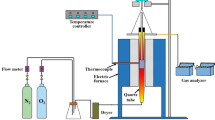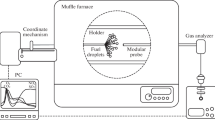Conclusions
-
1.
In the TSRT-2 apparatus (phase ratio 3.5/1) in 5-h tests at 150°C, establishing a nitrogen medium in the vapor space gives a fivefold to ninefold reduction of the amounts of gum and sediment formed.
-
2.
T-1 fuel that has been “nitrogenated” behaves like a high-stability hydrogenated fuel with respect to filter plugging in pumping tests at 180°C.
-
3.
“Nitrogenation” of fuels favors a reduction of carbon deposit formation on combustion chamber walls, does not decrease the completeness of combustion, and does not narrow the limits of stable combustion chamber operation.
Similar content being viewed by others
Literature cited
Ya. B. Chertkov, G. F. Bol'shakov, and E. I. Gulin, Jet Engine Fuels [in Russian], Nedra (1964).
B. D. Zalog (editor), in: Methods for Evaluating Service Properties of Jet Engine Fuels and Lubricants [in Russian], Mashinostroenie (1966).
Additional information
Translated from Khimiya i Tekhnologiya Topliv i Masel, No. 10, pp. 36–38, October, 1970.
Rights and permissions
About this article
Cite this article
Borisov, V.D., Malyshev, V.V. & Tereshchenko, E.R. Effect of oxygen on sediment and gum formation in fuels. Chem Technol Fuels Oils 6, 765–767 (1970). https://doi.org/10.1007/BF00716439
Issue Date:
DOI: https://doi.org/10.1007/BF00716439




